The shape of a guitar’s neck plays a massive role in how comfortable a guitar feels to play.
In this guide, I’ll explain the difference between the most common guitar neck shapes you’ll find on most guitars. You’ll learn why different shapes can suit different styles of playing and you’ll get a better idea of what type of neck shape is right for you.
I’ll also show you some unusual guitar neck shapes and why some guitarists love them.
After you read this guide, learn about guitar scale length and how it affects a guitar’s playability and neck length. Also, check out the guide on Guitar Neck Joints to learn about how the way a neck is connected to the body of the guitar can vary.
Most Common Guitar Neck Shapes
Let’s start with what guitar neck shapes are, then look at the most common neck shapes you’ll find.
A guitar neck shape is the shape of the back of the guitar neck running all the way from the headstock to the body. Guitar neck shapes look at the curve and depth of the neck.
You may have noticed that some guitars have chunky guitar necks and others have slim necks.
There are a few common guitar neck shapes that are found on most guitars. Here are the most common:

The above diagrams are cross-sections of the guitar neck. Think of it as slicing the guitar neck along one of the frets.
Guitar neck shapes are usually labeled with letters to roughly describe the shape they make. So a guitar with a ‘U’ shape neck will have a smoother curve compared to a ‘V’ shaped neck.
Let’s go through the main types of guitar neck shapes and what they’re like to play.
‘U’ Shape Neck
U shaped guitar necks are thick and chunky to hold. They feel like a baseball bat due to the rounded shape.
What makes U shape necks different from C or D shaped necks is the how deep the neck feels. Think of the U shape neck as a thick version of a C or D shape neck.
Many rock rhythms guitarists like these neck shapes as they can feel good to get a strong grip when bashing chords.
People with small hands may find these guitar necks harder to play compared to thinner neck shapes.
‘V’ Shape Neck
V shape necks tend to stand out as you can feel the straighter edges instead of a smooth curve in other types of neck shapes.
A V shape neck can be ‘soft’, which rounds out the middle curve, or ‘hard’, which has a more pronounced centre.
Many vintage guitars use V shaped necks and some guitarists like them as they can easily rest their thumb on a flatter surface compared to a more curved guitar neck.
‘C’ Shape Neck
C shaped guitar necks have a smooth curve all the way around the back of the neck. Most modern guitars will use some form of a C shape neck or a D shaped neck, which is a flatter version of the C shape.
C shaped necks aren’t as deep or chunky as U shaped necks, but they can vary in thickness.
Most guitarists feel comfortable playing C shaped necks, but everybody is different and some prefer different shapes.
‘D’ Shape Neck
The D shaped neck is a flattened version of the popular C shape. Some guitarists call these necks ‘modern C’ shapes as they tend to look very similar.
‘Fast’ guitar necks usually use a D shape. These necks are thin to make it easier to reach over the fretboard and play fast parts.
If you compare the earlier diagrams of C and D shaped necks, you can see they’re very similar. The main difference to remember is that a D shaped neck tends to be flatter and thinner than a typical C shaped neck.
Remember that these labels aren’t very accurate, so there tends to be disagreement over what shape specific guitars are. If you’re looking for a list of guitars that match a specific neck shape, I wouldn’t rely on anything you read for this reason.
How to Find What Neck Shape Your Guitar Uses
Now that you know about the different neck shapes, you might wonder what type of neck shape your guitar uses.
It can be difficult to judge the shape of a neck by looking at it. The exact curve may not be obvious at first.
An easy way to figure out what type of neck shape your guitar uses it to take a length of string, your guitar cable, or anything similar and hold it against your guitar neck as shown below:
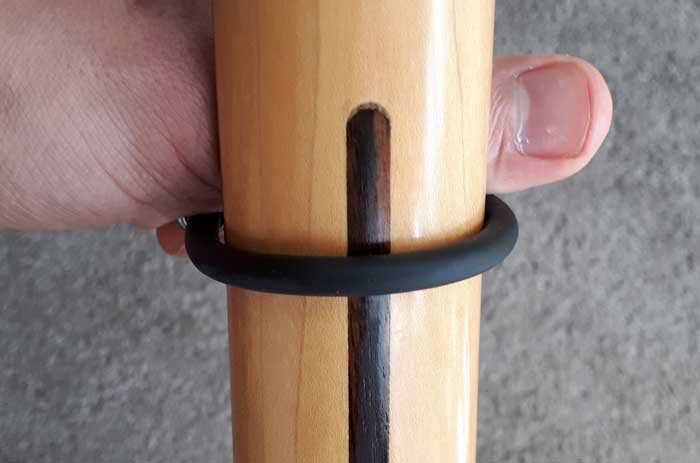
When you look down the back of the fretboard from the headstock (learn about all the parts of the guitar and their names here), you’ll have a clear idea of the shape of your guitar neck.
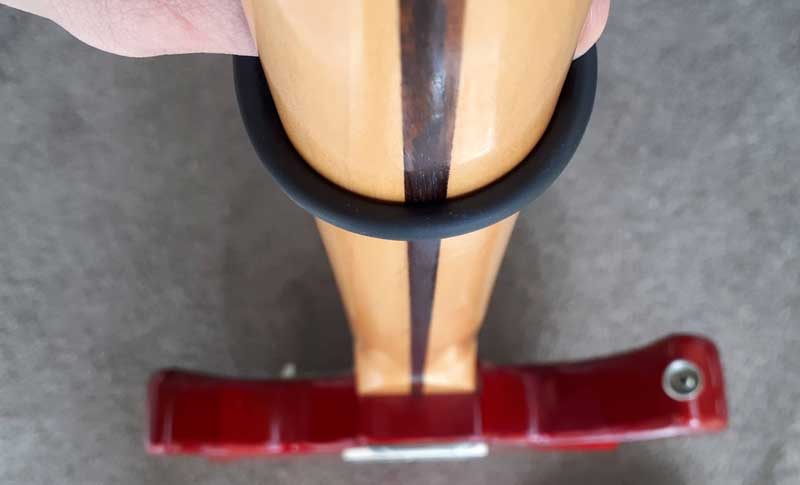
As an example, take a look at the above photo and compare it to the earlier diagrams to figure out what shape it uses.
You’ll find that most guitar necks sit somewhere between two different neck shapes. The above guitar seems to fit somewhere between a C and D shape, but it’s too thin to fit a U shape.
Just remember that these labels are just rough guides to help separate the different types of necks. It isn’t an exact science and it really doesn’t matter whether you call a neck a C or a D.
The only thing that matters is that you find a guitar neck that feels comfortable to play.
Understanding Guitar Neck Radius
When we talk about guitar neck shapes, we’re talking about the shape of the back of the neck. But the shape of the front of the neck (the fretboard) can also change.
The shape of the fretboard also changes across different guitars. The differences in shape aren’t as extreme as the back of the neck, but you may still notice slight changes as you play different guitars.
If you look at your frets, you’ll notice that they’re slightly curved as shown below:

Some guitar fretboards have a subtle curve, while others are more obvious.
The shape of this curve on the fretboard is based on a radius.
You may have seen guitars described as having a 7.25″ radius, or a 9.5″ radius, or a 16″ radius.
This number describes the size of the circle you would create if you extended the curve of the fretboard as shown in the below diagram:
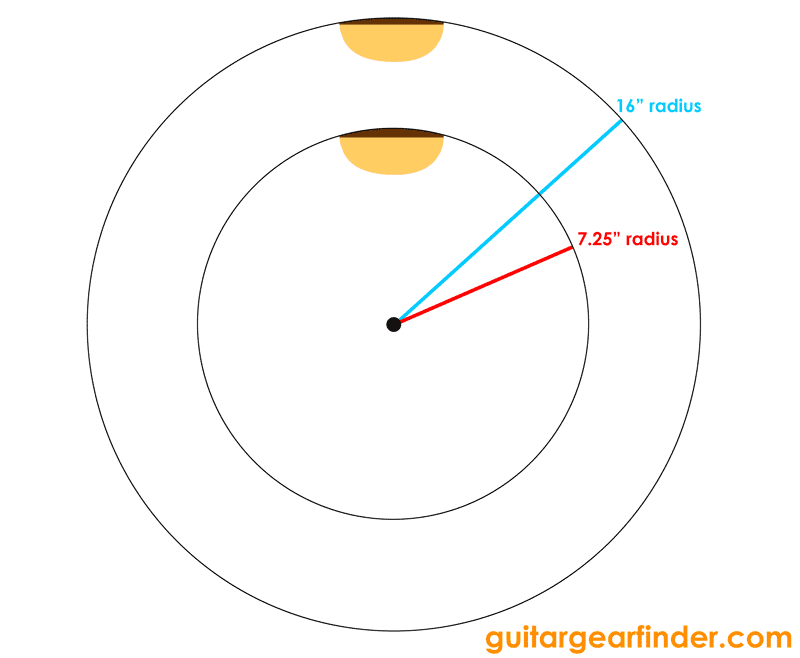
You can see that the larger circle creates a flatter fretboard compared to the smaller circle. This is the key point to remember with fretboard radius. The larger the number, the flatter the fretboard.
Here’s a close-up diagram comparing the differences in fretboard radius.

As you can see, the fretboard radius describes the slight curve you see running across the fretboard.
A guitar with a larger radius (eg: 16″), will have a flatter curve on the fretboard. A guitar with a low radius (eg: 7.25″), will have a bigger curve across the fretboard.
How Fretboard Radius Impacts Playability
Every aspect of a guitar affects playability in some way. Knowing how different guitar features impacts playbility is important so you can find the right type of guitar for you.
For example, the width of the fretboard impacts the spacing between strings and how easily you can squeeze your fingers into chord shapes. A wider fretboard makes playing open chords easier if you have thick fingers.
The scale length of a guitar impacts the distance between each fret as well as string tension. Playing a guitar with a short scale length and switching to a guitar with a long scale length can feel completely different.
Fretboard radius also impacts playbility, but it is more subtle than other aspects such as fretboard width or scale length. The fretboard radius changes how it feels playing chords as well as moving through the strings.
The typical view with fretboard radius is that a large radius (flat fretboard) feels more comfortable when playing scale runs, bends, vibrato, or any single-note riffing. A smaller radius (curved fretboard) tends to feel more comfortable when playing chords.
Imagine playing a barre chord on a guitar with a small radius (curved fretboard). The fretboard radius will better match the natural curve in your finger compared to a flat fretboard.
Some guitarists don’t notice any difference in playbility when changing fretboard radius, while other guitarists are specific on what radius they prefer playing.
How To Choose a Guitar Neck Shape
After reading about the different types of guitar neck shapes, you may or may not have an idea which shape might be right for you.
The truth is there’s no way to really know which neck shape will feel best to you until you try them out.
In theory, you may think that you want a thin neck to help you play fast solos. But you might pick up a guitar with a V shaped neck and love how it feels.
The best way to choose a guitar neck shape is to try out a wide range of guitars and feel each type of neck. Play a guitar without looking at what type of neck shape it uses and just feel what it’s like to play.
If you go to a guitar shop thinking that you want a C shaped guitar neck and you only try out C shaped necks, you’ll never truly know if any of the other guitar neck shapes suit you better.
Many guitarists buy one type of guitar neck and grow accustomed to it over time. Then when they play a guitar with a different shaped neck, it feels weird at first.
But over time, you may find that you prefer a different guitar neck shape compared to what you normally play.
Keep an open mind with guitar neck shapes and don’t feel you have to stick with one type.
Best Guitar Neck Shape for Small Hands
If you have small hands, you may wonder what the best neck shape is for you.
The best guitar neck shape for small hands tends to be a flat neck that allows your fingers easier access to the fretboard. Fat guitar necks can make it harder to reach your fingers over the fretboard.
Of course, everybody is different and what feels completely comfortable for one person may not feel comfortable for you. Try out a few different guitar neck shapes to find out which feels the most comfortable for you.
Read my Ultimate Guide to Guitar for Small Hands to learn everything you need to know about finding the right guitar for you.
Asymmetrical Guitar Necks
Most guitar necks are symmetrical all the way down the neck. The centre of the back of the neck is the centre of the curve and that curve is straight all the way down to the guitar body.
But there are some guitar necks that mix this up. Asymmetrical guitar necks can shift the curve and change the location of the curve as you move up or down the neck.
The below diagram compares the cross section of a symmetrical guitar neck and an asymmetrical guitar neck.

The symmetrical guitar neck has the same curve on both sides of the centre. The asymmetrical guitar neck feels fatter on one side and thinner on the other side.
In the below diagram, you can see how an asymmetrical guitar neck varies the shape of the curve off-centre:
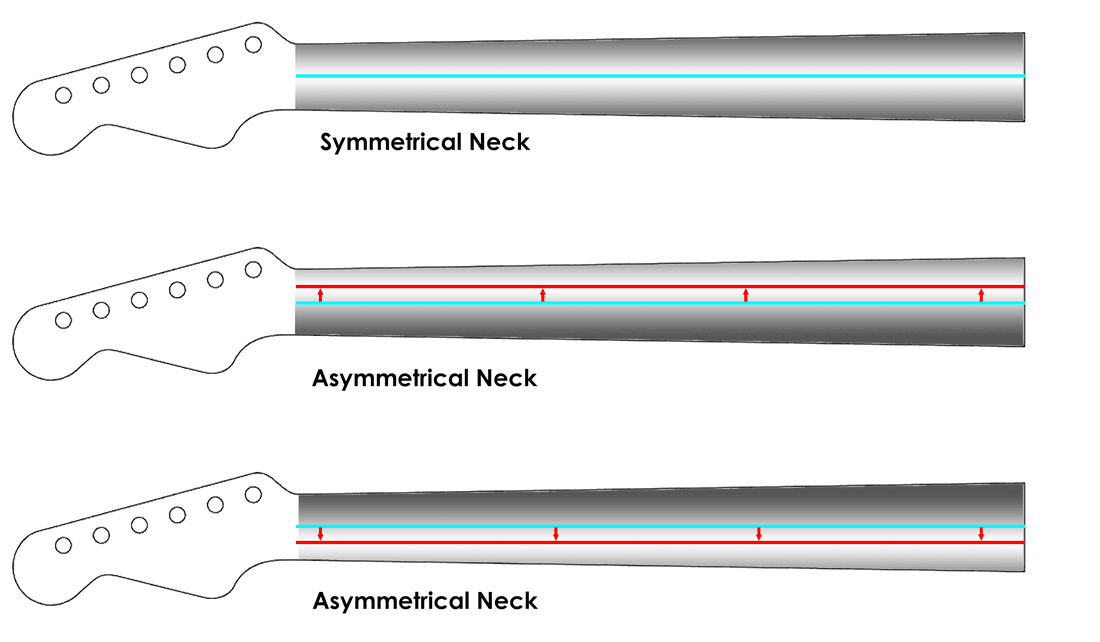
The blue line in the diagram shows the center of the neck. In a symmetrical guitar neck, this is also the centre of the curve. The red lines in the other two diagrams show how asymmetrical necks shift the centre of the curve.
Some asymmetrical guitar necks shift the curve closer to the top of the fretboard, while others shift the curve closer to the bottom of the fretboard.
Some guitarists prefer asymmetrical guitar necks and feel they better match the way our hands hold a guitar.
Asymmetrical guitar necks can also change the curve as you move up and down the fretboard as shown in the below diagram:
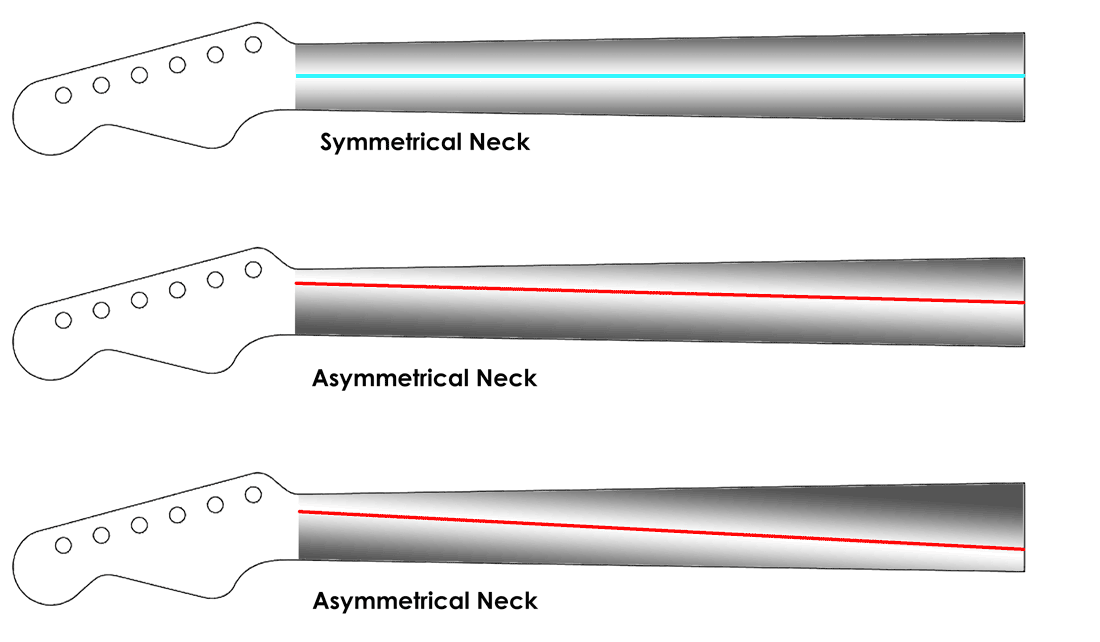
You can see that a standard guitar neck keeps the curve of the neck the same across the entire length. The centre of the curve stays in the center of the neck.
Asymmetrical guitar necks can shift this position as you move up the neck. The idea behind this type of asymmetrical guitar neck is to try and match the way our hand posture changes as we move up the neck.
The angle of your hand will change as you move up the neck, so in some ways it makes sense to also change the position of the neck’s curve.
Some guitarists feel asymmetrical guitar necks like these feel more natural to play, while other guitarists hate them.
The key point to remember when it comes to guitar neck shapes is that it’s all subjective. Every guitarist will have a different opinion on what type of guitar neck feels best. There is no right or wrong answers.
Strandberg EndurNeck
An extreme example of an asymmetrical guitar neck is with the Strandberg EndurNeck:
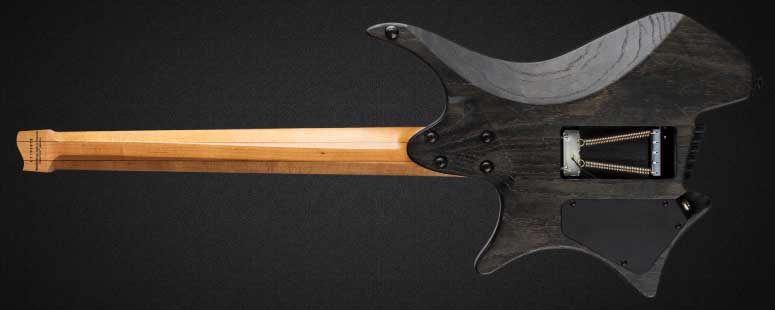
Strandberg guitars are already unusual when compared to typical guitars. But the back of the neck takes a completely different view of guitar ergonomics.
You can clearly see that the above guitar neck doesn’t match any of the standard shapes seen on most guitars. The EndurNeck uses a trapezoid shape, which is odd compared to typical guitars.
But the Enduraneck is also asymmetrical. You can see that the flat middle part of the neck shifts position as you move up the neck.

The idea here is that the trapezoid shape changes as you move up the fretboard to match the way your hand position changes. You can either place your thumb on the centre flat part of the neck, or on the upper surface.
If you haven’t played an asymmetrical guitar neck before, your first instinct might be that it looks awkward.
The first time I played a Strandberg, I expected it to feel awkward and was shocked by how comfortable it felt. It immediately felt natural to play and far more comfortable than any other guitar I had played before.
Again, every guitarist is different and asymmetrical guitar necks aren’t for everyone. Some people prefer the Strandberg necks immediately, others take some time to get used to them, while other guitarists can’t stand them.
The main point to remember is that there is no perfect guitar neck shape that suits everybody. You may like an asymmetrical guitar neck, or you may prefer a symmetrical guitar neck. Try out both and see what feels best for you.
Guitar Neck Shapes FAQ
Here are some common questions you might have about guitar neck shapes.
What is the Best Guitar Neck Shape?
There is no best guitar neck shape because every guitarist has different preferences. Some guitarists prefer a thicker and rounder guitar neck to grip, while others prefer a flatter or thinner neck.
The only way to find out what the best guitar neck shape is for you is to try a few different shapes and see what feels the most comfortable.
Are There Different Size Guitar Necks?
The size of a guitar neck can vary widely between different brands and models. There can be a massive difference in scale length, which is the overall length of a guitar neck. The width of a guitar neck and the radius can also vary.
Find out about the most common sizes of guitar necks in my Ultimate Guide to Guitar Scale Length. The guide also explains how to measure the scale length of any guitar.
Are Wide Neck Guitars Easier to Play?
Wide guitar necks create more space between each string, which can make playing chords easier. You’re less likely to accidentally mute adjacent strings on wide guitar necks. Wider necks can also make some things harder to play as they require you to stretch out further.
Some guitarists prefer wider necks and others don’t. Instead of trying to find a guitar that might make things easier to play, focus on finding the type of guitar that best suits the music you want to play.
What Does a Fast Neck Mean?
A fast neck is a guitar that has been set up to make it easier to play fast parts. The neck tends to have a thin and flat shape to improve fret access. Low action height and larger frets can also help a guitar neck feel fast.
While you can play fast guitar parts on any type of guitar with enough practice, some guitar necks will feel easier than others. Guitars marketed as having a ‘fast neck’ tend to feel more comfortable playing fast parts.
Now that you know about different guitar neck shapes, here are a couple of other important things to know about guitar necks and setups:
- Guitar Scale Length: this important guide explains how the length of a guitar neck can change and how it impacts how a guitar feels to play
- Guitar Action Height: if your guitar feels uncomfortable, it might be due to action
- Guitar Truss Rods: learn how to keep your guitar neck straight using a truss rod
- Guitar Neck Joints: learn about the different ways a guitar neck can be connected to a guitar body
- Guitar Sizes: if you’re worried about the size of a guitar neck, read this guide to learn about different size guitars
